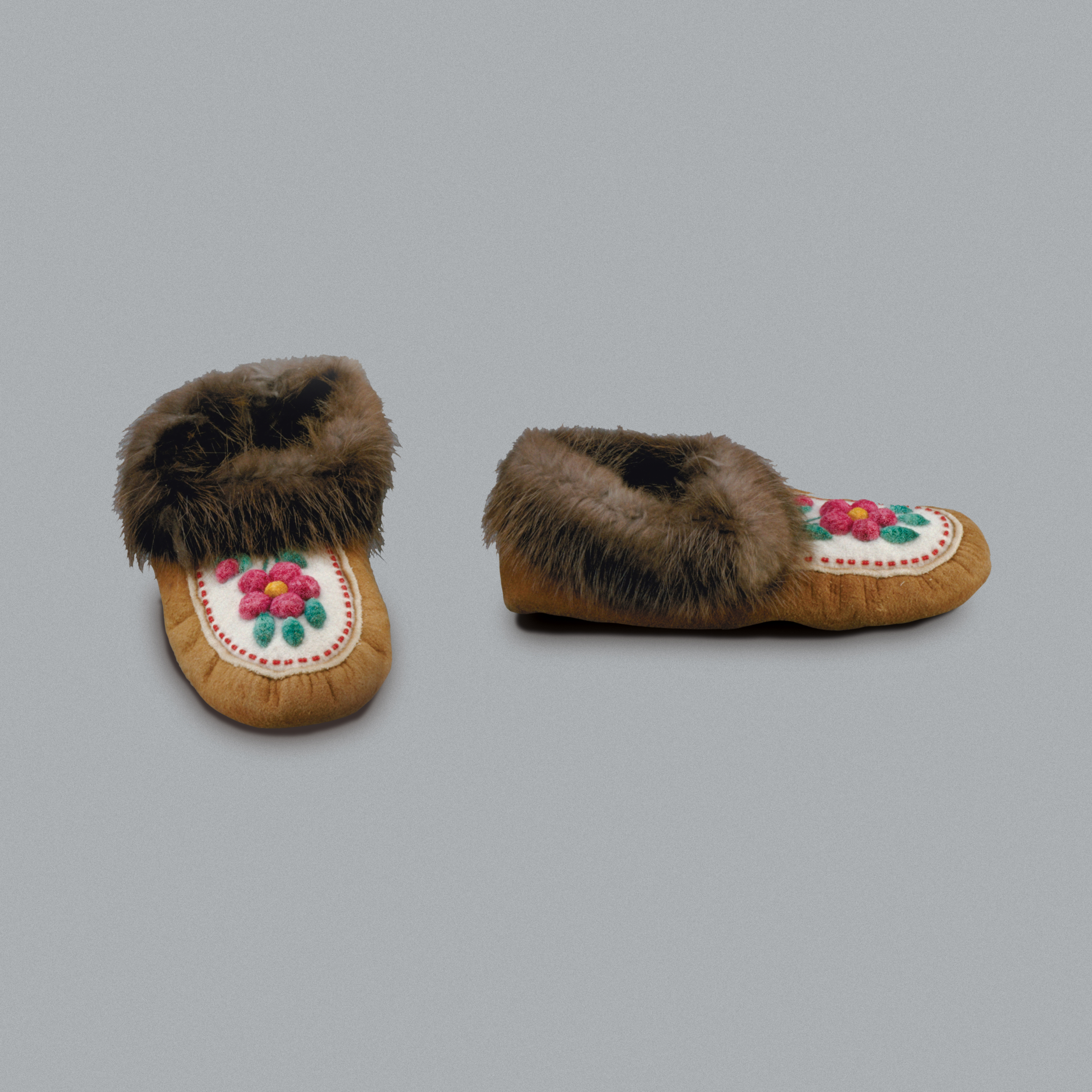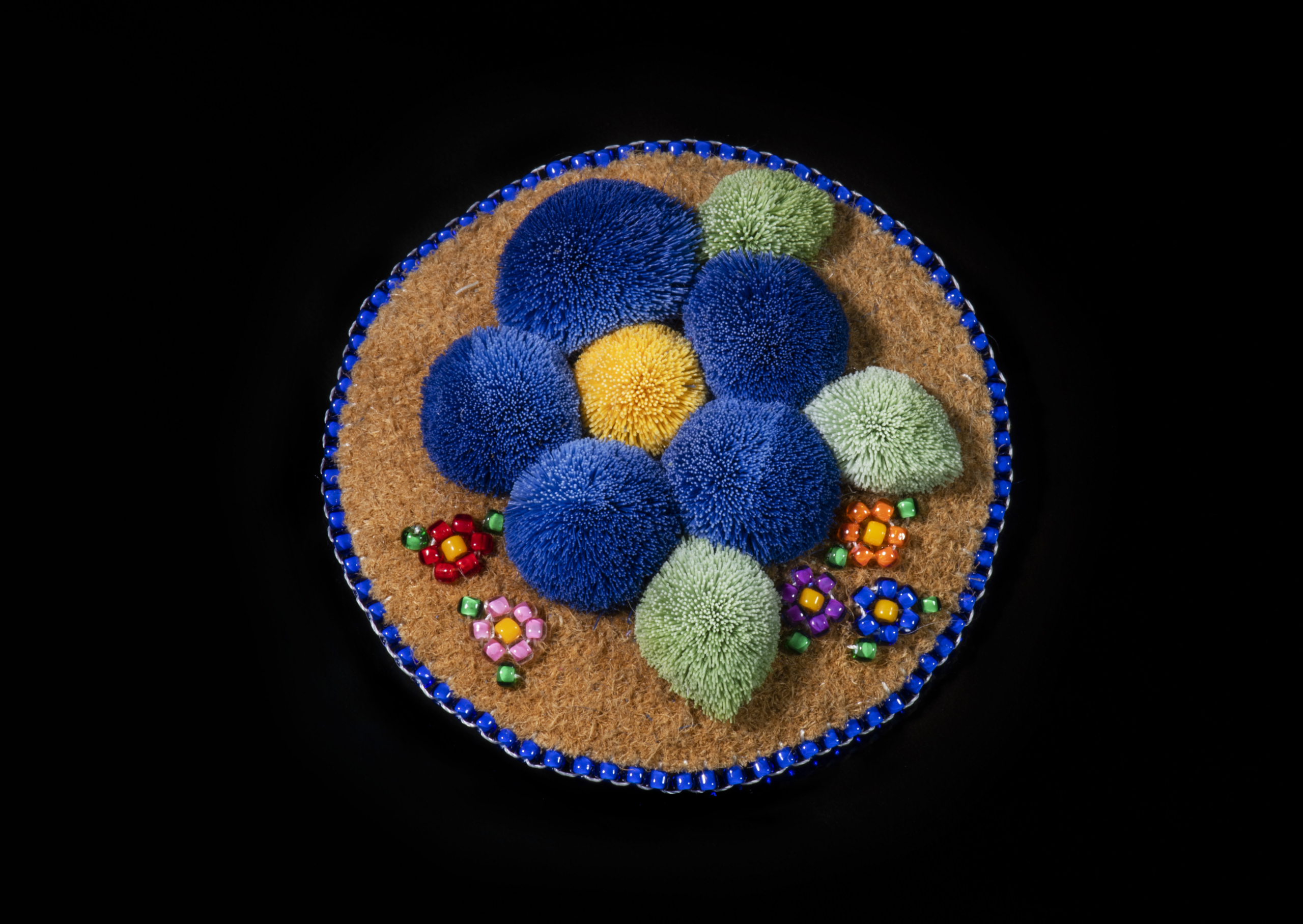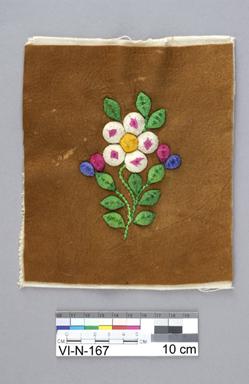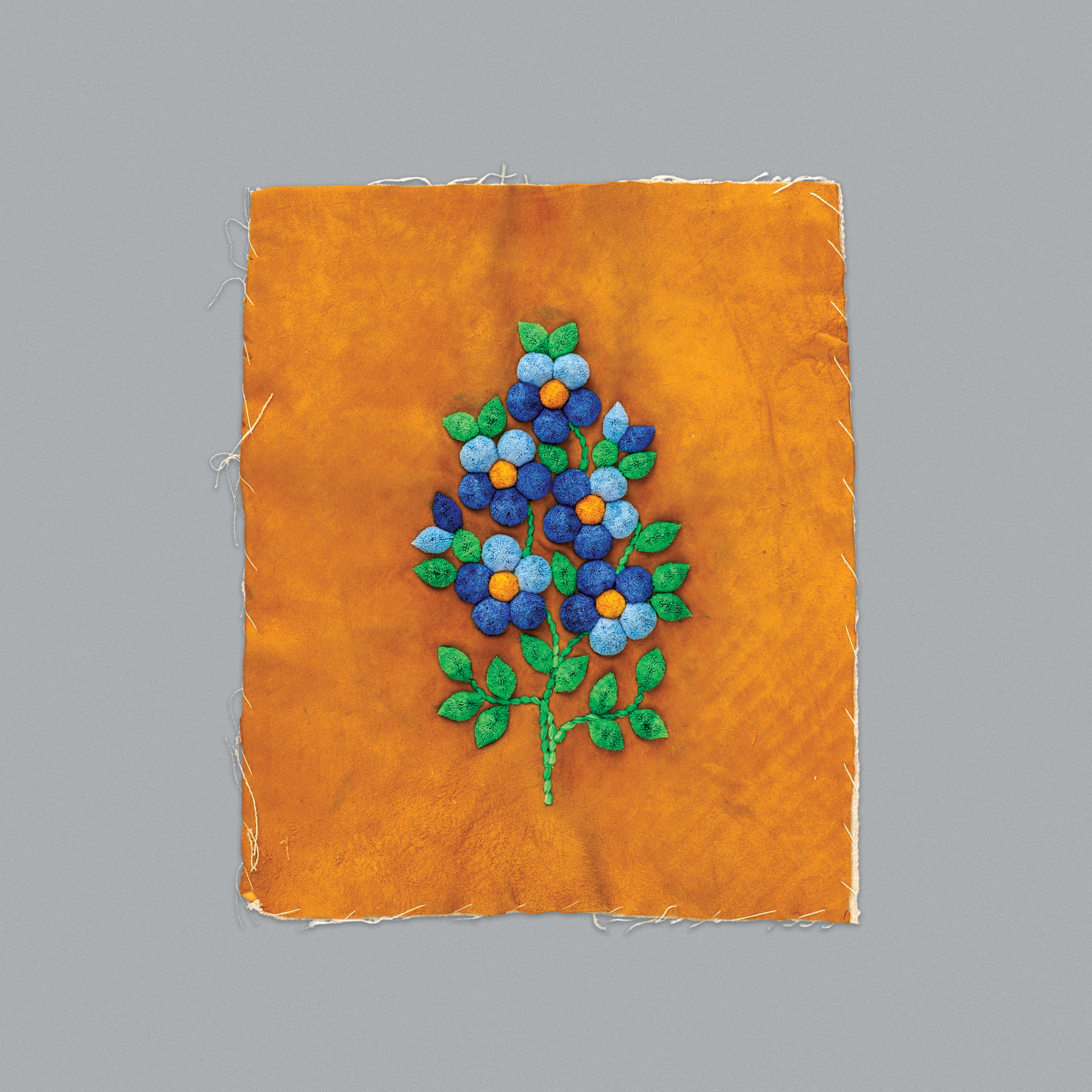Moose/Caribou Hair Tufting
Artifact
Image
Video
Audio
 Activities
Activities
LOOK
Look at the different examples of moose hair tufting in the media carousel above. What are some similarities and differences between them?
THINK
Watch the interview with Carmen Miller, who created art pieces for the History Box. She explains the process of tufting and its cultural importance. What questions would you ask Carmen, if you could?
Details
 Materials
Materials - Moosehide
- Moosehide hair
- Beaver fur
- Glass beads
- Cotton
Historical Context
Choose one of the three levels below to match your needs.
- Moose/caribou hair tufting began at the turn of the 20th century in the Northwest of what is now Canada.
- Bundles of moose/caribou hair are applied to a backing to create a three-dimensional image.
- Here, moose/caribou hair tufting has been used to create the green leaves and red flowers that decorate a pair of moccasins.
Scroll through the media carousel above to see a photograph of the art pieces found in the History Box, and interview with Carmen Miller, the artist who made them, and some examples from the collections held at the Canadian Museum of History.
Moose/caribou hair tufting began at the turn of the 20th century in the Northwest of what is now Canada. This art form, in which bundles of moose/caribou hair are applied to a backing to create a three-dimensional image, was built on the enduring artistic practice of moose/caribou hair twisting.
Gathered between December and March, winter fur is harvested in lengths of 15 to 20 centimetres taken from the shoulder and rump of the moose. Picked, sorted by size and washed by hand, this white hair is dyed.
After the hair is dried, a loop stitch is made around 15 to 20 hairs of the same length about half a centimetre from the end and then pulled tight against a backing. This creates a pompom-like form that is then shaped with scissors to create a tuft.
Here, moose/caribou hair tufting has been used to create the green leaves and red flowers that decorate a pair of moccasins.
Moose/caribou hair tufting began at the turn of the 20th century in the Northwest of what is now Canada. This art form, in which bundles of moose/caribou hair are applied to a backing to create a three-dimensional image, was built upon the enduring artistic practice of moose/caribou hair twisting.
Gathered between December and March, winter fur is harvested in lengths of 15 to 20 centimetres, taken from the shoulder and rump of the moose. Picked, sorted by size, and washed by hand, this white hair is dyed using roots, lichen, flowers, bark, berries and, increasingly, commercial dyes.
After the hair is dried, a loop stitch is made around 15 to 20 hairs of the same length, about half a centimetre from the end. It is then pulled tight against a backing. Using tanned hide, velvet or another backing of choice, this creates a pompom-like form that is then shaped with scissors to create a tuft. After all of the tufts have been sculpted into the desired shape, embroidery or beading is sometimes added to the design. Moose/caribou hair tufting was at one time found almost exclusively on clothing and accessories, but it has now become popular as framed art.
In these moccasins, moose/caribou hair tufting has been used to create the green leaves and red flowers. Just below the beaver-fur trim, the vamp (top of the moccasin) has been outlined with red glass beads. Moose/caribou hair tufting is an art form that calls for a unique set of skills: each flower can take between six and eight hours to complete.
The moose/caribou hair tufting examples found in the History Box were made by Carmen Miller, a Métis artist from Alberta.
- Moose/caribou hair tufting began at the turn of the 20th century in the Northwest of what is now Canada.
- Bundles of moose/caribou hair are applied to a backing to create a three-dimensional image.
- Here, moose/caribou hair tufting has been used to create the green leaves and red flowers that decorate a pair of moccasins.
Scroll through the media carousel above to see a photograph of the art pieces found in the History Box, and interview with Carmen Miller, the artist who made them, and some examples from the collections held at the Canadian Museum of History.
Moose/caribou hair tufting began at the turn of the 20th century in the Northwest of what is now Canada. This art form, in which bundles of moose/caribou hair are applied to a backing to create a three-dimensional image, was built on the enduring artistic practice of moose/caribou hair twisting.
Gathered between December and March, winter fur is harvested in lengths of 15 to 20 centimetres taken from the shoulder and rump of the moose. Picked, sorted by size and washed by hand, this white hair is dyed.
After the hair is dried, a loop stitch is made around 15 to 20 hairs of the same length about half a centimetre from the end and then pulled tight against a backing. This creates a pompom-like form that is then shaped with scissors to create a tuft.
Here, moose/caribou hair tufting has been used to create the green leaves and red flowers that decorate a pair of moccasins.
Moose/caribou hair tufting began at the turn of the 20th century in the Northwest of what is now Canada. This art form, in which bundles of moose/caribou hair are applied to a backing to create a three-dimensional image, was built upon the enduring artistic practice of moose/caribou hair twisting.
Gathered between December and March, winter fur is harvested in lengths of 15 to 20 centimetres, taken from the shoulder and rump of the moose. Picked, sorted by size, and washed by hand, this white hair is dyed using roots, lichen, flowers, bark, berries and, increasingly, commercial dyes.
After the hair is dried, a loop stitch is made around 15 to 20 hairs of the same length, about half a centimetre from the end. It is then pulled tight against a backing. Using tanned hide, velvet or another backing of choice, this creates a pompom-like form that is then shaped with scissors to create a tuft. After all of the tufts have been sculpted into the desired shape, embroidery or beading is sometimes added to the design. Moose/caribou hair tufting was at one time found almost exclusively on clothing and accessories, but it has now become popular as framed art.
In these moccasins, moose/caribou hair tufting has been used to create the green leaves and red flowers. Just below the beaver-fur trim, the vamp (top of the moccasin) has been outlined with red glass beads. Moose/caribou hair tufting is an art form that calls for a unique set of skills: each flower can take between six and eight hours to complete.
The moose/caribou hair tufting examples found in the History Box were made by Carmen Miller, a Métis artist from Alberta.
Summary
- Moose/caribou hair tufting began at the turn of the 20th century in the Northwest of what is now Canada.
- Bundles of moose/caribou hair are applied to a backing to create a three-dimensional image.
- Here, moose/caribou hair tufting has been used to create the green leaves and red flowers that decorate a pair of moccasins.
Scroll through the media carousel above to see a photograph of the art pieces found in the History Box, and interview with Carmen Miller, the artist who made them, and some examples from the collections held at the Canadian Museum of History.
Essential
Moose/caribou hair tufting began at the turn of the 20th century in the Northwest of what is now Canada. This art form, in which bundles of moose/caribou hair are applied to a backing to create a three-dimensional image, was built on the enduring artistic practice of moose/caribou hair twisting.
Gathered between December and March, winter fur is harvested in lengths of 15 to 20 centimetres taken from the shoulder and rump of the moose. Picked, sorted by size and washed by hand, this white hair is dyed.
After the hair is dried, a loop stitch is made around 15 to 20 hairs of the same length about half a centimetre from the end and then pulled tight against a backing. This creates a pompom-like form that is then shaped with scissors to create a tuft.
Here, moose/caribou hair tufting has been used to create the green leaves and red flowers that decorate a pair of moccasins.
In-Depth
Moose/caribou hair tufting began at the turn of the 20th century in the Northwest of what is now Canada. This art form, in which bundles of moose/caribou hair are applied to a backing to create a three-dimensional image, was built upon the enduring artistic practice of moose/caribou hair twisting.
Gathered between December and March, winter fur is harvested in lengths of 15 to 20 centimetres, taken from the shoulder and rump of the moose. Picked, sorted by size, and washed by hand, this white hair is dyed using roots, lichen, flowers, bark, berries and, increasingly, commercial dyes.
After the hair is dried, a loop stitch is made around 15 to 20 hairs of the same length, about half a centimetre from the end. It is then pulled tight against a backing. Using tanned hide, velvet or another backing of choice, this creates a pompom-like form that is then shaped with scissors to create a tuft. After all of the tufts have been sculpted into the desired shape, embroidery or beading is sometimes added to the design. Moose/caribou hair tufting was at one time found almost exclusively on clothing and accessories, but it has now become popular as framed art.
In these moccasins, moose/caribou hair tufting has been used to create the green leaves and red flowers. Just below the beaver-fur trim, the vamp (top of the moccasin) has been outlined with red glass beads. Moose/caribou hair tufting is an art form that calls for a unique set of skills: each flower can take between six and eight hours to complete.
The moose/caribou hair tufting examples found in the History Box were made by Carmen Miller, a Métis artist from Alberta.




